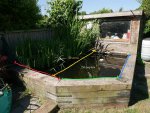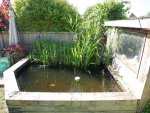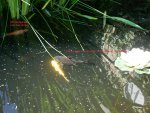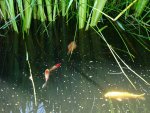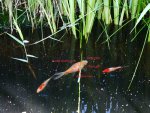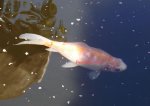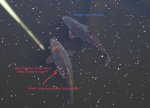- Joined
- Jun 25, 2018
- Messages
- 14
- Reaction score
- 5
- Country

hello everyone. This is a long one but please bare with.
So we moved into our home in Bedfordshire in November 2015, knew there was pond but the lady we bought the house off said there was ‘a few fish in there’ and there was a pump&filter there but she hadn’t had is working for ‘years’
We ignored it as had a 10month old and it was winter anyway. Next summer (2016) we saw some fish but only really a white one and a orange one, they weren’t that big and the water was really murky. I was quite pregnant with 2nd baby so again we weren’t ready to deal with improving the pond.
Summer 2017 and we couldn’t see the white one anymore, just the orange one. A neighbour told us he’d seen a heron on the roof of our shed one morning so we thought that was it and the heron had most of the fish that were in there. With 2 children under 2 we were more concerned about the pond being a potential hazard so largely kept away from it.
Spring 2018 weekend of April 14/15 - husband is really quite handy at gadgets and gizmos so decided he was going to get the pump and filter working after doing some research. The filter is a OASE Biotech 10 which is obviously an old model but we found a manual pdf and husband cleaned it up and got it working. The pump was a OASE aquamax 15000. So by the time he’d fiddled with it and replaced what needed replacing (there’s a UV filter Oase Bitron 25 on the filter too) it was the evening of Monday 16th April and he decided to leave the filter on overnight in the naive hope that we’d wake to a clear pond and be able to see what was going on in there......
Tuesday 17th April we woke up to a near empty pond!!!! Only black sludge below the point of the pump was left with a good few unhappy flappy fish. Clearly a stressful event for them. Husband stayed home from work and we scooped out all the fish into so big plastic tubs of tap water and pond sludge. Once we were happy we’d got them all out we pumped up the children’s paddling pool and filled with tap water through the hose and dumped the contents of the big tubs in it. With all the fish in the paddling pool we shovelled out the sludge and husband reattached the pond hose back on the back of the filter. Turns out the hose had come off the back because there was no jubilee clip so water was being pumped out to the back of the shed. Our neighbour is quite pleased as all his plants in that area the other side of our fence have come up really well this year .
So when we’d filled the pond again we counted the fish (and frogs and newts) we counted 20 fish; 10 big and medium, and 10 small ones. When I say ‘big’ I mean between 7”-12” which I now appreciate isn’t that big at all. And one had barbels so I realised it was a koi - on further research it’s a ghost koi/carp as is black with orange underneath so to speak and more orange on its head. This is our biggest being about 12” long. I also rescued hundreds of damselfly nymphs and being a biology teacher I know these to be a sign of good water quality and a healthy pond so I was happy that despite its neglect the pond up to that point had been fine.
So we refilled the pond reinstated the fish and with the hope visibility would get clearer with the now working pump and filter we went out and bought some more fish from our local koi place. We got a shiny yellow koi, a Beni kiko(?) a orange one with floaty delicate fins, two little white ones with orange blobs on the top which I think are goldfish. ( I will try to add photos of these).
Happy days.
Visibility was getting a little better and we named them. Then a fortnight ago I noticed the new orange/black one with the lovely fins no longer had it’s front pectoral fins!! Well one was missing entirely and the other side it was short and just a stump. I tried to catch it to get a closer look but I didn’t try that hard thinking I’ll try again the next day. I’ve never seen it again . So pretty sure it’s dead and sunk.
Being on the look out for ‘Magic Mike’ on a daily basis I noticed a white lump on a 8” black carp - on the top section of its caudal fin. I monitored this for a few days and it seemed to be getting worse. Then last Wednesday 20th June - I went out to see them and he’d blown up like a balloon. At this point I knew he was sick and dr google said dropsy/pine cone disease, which said was symptom with several causes one of which is bacterial infection which fits with the white lump) I went and checked the filter behind the shed as husband was at work and it was full with black sludge. I scrapped off as much as I could whilst the filter was off. I was going off on a timer between 1-2pm every afternoon. I know this will have been a bacterial paradise in there so When husband returned from work we took the sponges out of the filter ( only the course ones in the first side the water goes through - 3 green ones) where i’d scraped off the sludge. I also managed to catch the dropsy carp to take photos and it squeaked a lot - I will add the photos, and that when we saw the white lump was dead skin which came off to reveal a hole!
When we’d fitted them back in and went to turn it back on - the pump broke!!
So Thursday 21st June I went first thing to the Koi specialist up the road and sort their advice. I came home with a Pondlab 200 test kit and a packet of Cloverleaf Absolute-cT. test results are as follows:
pH7, NH3 0, NO2 0 NO3 0, KH 8, GH12.
So felt confident that the water quality was good enough to start a course of Choromine t, after my husband had been able to replace the pump which I also had to purchase. So that evening he swapped out the broken aquamax 15000, for a Superfish pond eco plus RC 15000. I chose this one on recommendation of the koi place and the fact we could vary the flow rate in the winter. Also the instruction manual for the biotec 10 which I took along with me to the specialist said the max recommended pump for that filter is only 10000. I didn’t want to replace with a 15000 just in case the flow rate was too high for the water to have adequate time in the filter. So it’s now on setting 4 which is 10,000 l/h.
The specialist said the dropsy carp was probably a dead fish swimming and I should look to the other fish for signs that the c-T was working. I was pretty certain the original orange goldfish had an abrasion on the side so was told this was the one to watch.
An online pond volume calculator told me the volume was about 1006 gallons so have added 10g in a litre of tap water every morning (thurs,fri,sat,sun) - haven’t added today because it said to only do 4 days.
So today is day 5 and ‘Mr Orange’ the orange goldfish has been sad all week hiding in the reed roots and only swimming about when he realises the others are feeding, and he does come and feed. Today I see (in the much clearer water) that he is pineconing as well so has gotten worse. Also there is a small fish that’s had gill rot as I can see I bright red patch of gills on one side only. And the ghost fish has got some loose or missing scales only on one side - well I’m interpreting loose scales as are about 5/6 grey scales.
So that’s the info, here are my questions!!
Do I need to empty out part of the water and refill to be of some benefit? Do I need to wait a few days and then do another 4days of cT? Or do i need to get another product because the bacterial strain present is resistant to cT? Should the gold fish have gotten better or could it be that his abrasion was too extensive to allow him to heal effectively so he has taken on water regardless of the bacterial count being reduced? The dropsy black carp is still going strong and swimming about like nothing is wrong with him which I’m surprised at seeing as magic mike disappeared overnight without developing dropsy! His hole wasn’t getting better but neither was it getting worse but I think he must have caught it somehow over night as the caudal fin has now ripped from the hole to the end. Also today when I fed them and he came to the surface bubbles of air came out of his gills! I’m guessing this is a very very bad sign and he is close to deaths door.
Also could it be parasitic instead of bacterial, but I’m not seeing them rubbing up against things or wriggling about?
Now having written this mammoth essay I’ve now got to get the photos up for you to see the pond and fish in question.
Thank you in advance to all those who make it to the end and are able to respond to help me out. I’ve gotten quite attached to these guys now and would hate to see them all go.
So we moved into our home in Bedfordshire in November 2015, knew there was pond but the lady we bought the house off said there was ‘a few fish in there’ and there was a pump&filter there but she hadn’t had is working for ‘years’
We ignored it as had a 10month old and it was winter anyway. Next summer (2016) we saw some fish but only really a white one and a orange one, they weren’t that big and the water was really murky. I was quite pregnant with 2nd baby so again we weren’t ready to deal with improving the pond.
Summer 2017 and we couldn’t see the white one anymore, just the orange one. A neighbour told us he’d seen a heron on the roof of our shed one morning so we thought that was it and the heron had most of the fish that were in there. With 2 children under 2 we were more concerned about the pond being a potential hazard so largely kept away from it.
Spring 2018 weekend of April 14/15 - husband is really quite handy at gadgets and gizmos so decided he was going to get the pump and filter working after doing some research. The filter is a OASE Biotech 10 which is obviously an old model but we found a manual pdf and husband cleaned it up and got it working. The pump was a OASE aquamax 15000. So by the time he’d fiddled with it and replaced what needed replacing (there’s a UV filter Oase Bitron 25 on the filter too) it was the evening of Monday 16th April and he decided to leave the filter on overnight in the naive hope that we’d wake to a clear pond and be able to see what was going on in there......
Tuesday 17th April we woke up to a near empty pond!!!! Only black sludge below the point of the pump was left with a good few unhappy flappy fish. Clearly a stressful event for them. Husband stayed home from work and we scooped out all the fish into so big plastic tubs of tap water and pond sludge. Once we were happy we’d got them all out we pumped up the children’s paddling pool and filled with tap water through the hose and dumped the contents of the big tubs in it. With all the fish in the paddling pool we shovelled out the sludge and husband reattached the pond hose back on the back of the filter. Turns out the hose had come off the back because there was no jubilee clip so water was being pumped out to the back of the shed. Our neighbour is quite pleased as all his plants in that area the other side of our fence have come up really well this year .
So when we’d filled the pond again we counted the fish (and frogs and newts) we counted 20 fish; 10 big and medium, and 10 small ones. When I say ‘big’ I mean between 7”-12” which I now appreciate isn’t that big at all. And one had barbels so I realised it was a koi - on further research it’s a ghost koi/carp as is black with orange underneath so to speak and more orange on its head. This is our biggest being about 12” long. I also rescued hundreds of damselfly nymphs and being a biology teacher I know these to be a sign of good water quality and a healthy pond so I was happy that despite its neglect the pond up to that point had been fine.
So we refilled the pond reinstated the fish and with the hope visibility would get clearer with the now working pump and filter we went out and bought some more fish from our local koi place. We got a shiny yellow koi, a Beni kiko(?) a orange one with floaty delicate fins, two little white ones with orange blobs on the top which I think are goldfish. ( I will try to add photos of these).
Happy days.
Visibility was getting a little better and we named them. Then a fortnight ago I noticed the new orange/black one with the lovely fins no longer had it’s front pectoral fins!! Well one was missing entirely and the other side it was short and just a stump. I tried to catch it to get a closer look but I didn’t try that hard thinking I’ll try again the next day. I’ve never seen it again . So pretty sure it’s dead and sunk.
Being on the look out for ‘Magic Mike’ on a daily basis I noticed a white lump on a 8” black carp - on the top section of its caudal fin. I monitored this for a few days and it seemed to be getting worse. Then last Wednesday 20th June - I went out to see them and he’d blown up like a balloon. At this point I knew he was sick and dr google said dropsy/pine cone disease, which said was symptom with several causes one of which is bacterial infection which fits with the white lump) I went and checked the filter behind the shed as husband was at work and it was full with black sludge. I scrapped off as much as I could whilst the filter was off. I was going off on a timer between 1-2pm every afternoon. I know this will have been a bacterial paradise in there so When husband returned from work we took the sponges out of the filter ( only the course ones in the first side the water goes through - 3 green ones) where i’d scraped off the sludge. I also managed to catch the dropsy carp to take photos and it squeaked a lot - I will add the photos, and that when we saw the white lump was dead skin which came off to reveal a hole!
When we’d fitted them back in and went to turn it back on - the pump broke!!
So Thursday 21st June I went first thing to the Koi specialist up the road and sort their advice. I came home with a Pondlab 200 test kit and a packet of Cloverleaf Absolute-cT. test results are as follows:
pH7, NH3 0, NO2 0 NO3 0, KH 8, GH12.
So felt confident that the water quality was good enough to start a course of Choromine t, after my husband had been able to replace the pump which I also had to purchase. So that evening he swapped out the broken aquamax 15000, for a Superfish pond eco plus RC 15000. I chose this one on recommendation of the koi place and the fact we could vary the flow rate in the winter. Also the instruction manual for the biotec 10 which I took along with me to the specialist said the max recommended pump for that filter is only 10000. I didn’t want to replace with a 15000 just in case the flow rate was too high for the water to have adequate time in the filter. So it’s now on setting 4 which is 10,000 l/h.
The specialist said the dropsy carp was probably a dead fish swimming and I should look to the other fish for signs that the c-T was working. I was pretty certain the original orange goldfish had an abrasion on the side so was told this was the one to watch.
An online pond volume calculator told me the volume was about 1006 gallons so have added 10g in a litre of tap water every morning (thurs,fri,sat,sun) - haven’t added today because it said to only do 4 days.
So today is day 5 and ‘Mr Orange’ the orange goldfish has been sad all week hiding in the reed roots and only swimming about when he realises the others are feeding, and he does come and feed. Today I see (in the much clearer water) that he is pineconing as well so has gotten worse. Also there is a small fish that’s had gill rot as I can see I bright red patch of gills on one side only. And the ghost fish has got some loose or missing scales only on one side - well I’m interpreting loose scales as are about 5/6 grey scales.
So that’s the info, here are my questions!!
Do I need to empty out part of the water and refill to be of some benefit? Do I need to wait a few days and then do another 4days of cT? Or do i need to get another product because the bacterial strain present is resistant to cT? Should the gold fish have gotten better or could it be that his abrasion was too extensive to allow him to heal effectively so he has taken on water regardless of the bacterial count being reduced? The dropsy black carp is still going strong and swimming about like nothing is wrong with him which I’m surprised at seeing as magic mike disappeared overnight without developing dropsy! His hole wasn’t getting better but neither was it getting worse but I think he must have caught it somehow over night as the caudal fin has now ripped from the hole to the end. Also today when I fed them and he came to the surface bubbles of air came out of his gills! I’m guessing this is a very very bad sign and he is close to deaths door.
Also could it be parasitic instead of bacterial, but I’m not seeing them rubbing up against things or wriggling about?
Now having written this mammoth essay I’ve now got to get the photos up for you to see the pond and fish in question.
Thank you in advance to all those who make it to the end and are able to respond to help me out. I’ve gotten quite attached to these guys now and would hate to see them all go.


